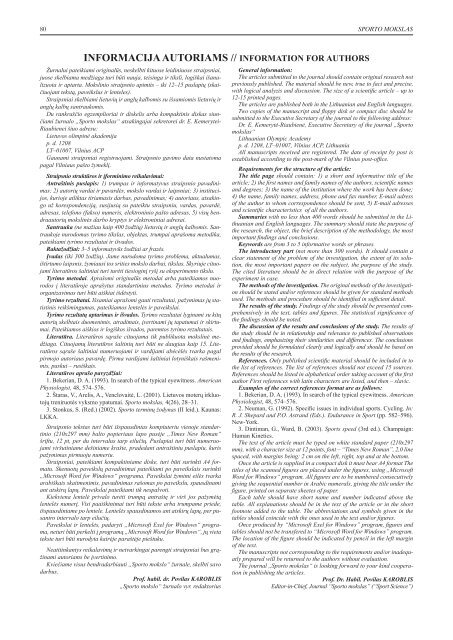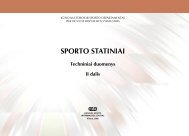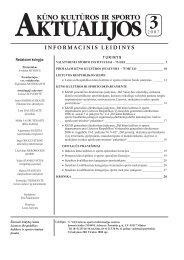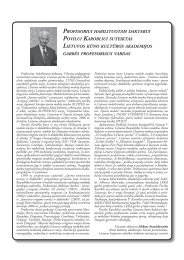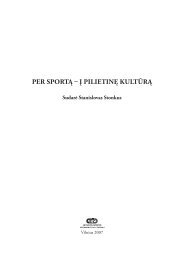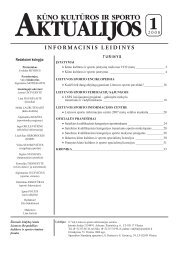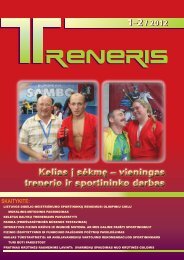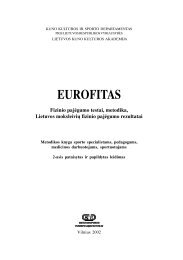Nr. 3 - Lietuvos sporto informacijos centras
Nr. 3 - Lietuvos sporto informacijos centras
Nr. 3 - Lietuvos sporto informacijos centras
Create successful ePaper yourself
Turn your PDF publications into a flip-book with our unique Google optimized e-Paper software.
80<br />
SPORTO MOKSLAS<br />
INFORMACIJA AUTORIAMS // Information for authors<br />
Žurnalui pateikiami originalūs, neskelbti kituose leidiniuose straipsniai,<br />
juose skelbiama medžiaga turi būti nauja, teisinga ir tiksli, logiškai išanalizuota<br />
ir aptarta. Mokslinio straipsnio apimtis – iki 12–15 puslapių (skaičiuojant<br />
tekstą, paveikslus ir lenteles).<br />
Straipsniai skelbiami lietuvių ir anglų kalbomis su išsamiomis lietuvių ir<br />
anglų kalbų santraukomis.<br />
Du rankraščio egzemplioriai ir diskelis arba kompaktinis diskas siunčiami<br />
žurnalo „Sporto mokslas“ atsakingajai sekretorei dr. E. Kemerytei-<br />
Riaubienei šiuo adresu:<br />
<strong>Lietuvos</strong> olimpinė akademija<br />
p. d. 1208<br />
LT–01007, Vilnius ACP<br />
Gaunami straipsniai registruojami. Straipsnio gavimo data nustatoma<br />
pagal Vilniaus pašto žymeklį.<br />
Straipsnio struktūros ir įforminimo reikalavimai:<br />
Antraštinis puslapis: 1) trumpas ir informatyvus straipsnio pavadinimas;<br />
2) autorių vardai ir pavardės, mokslo vardai ir laipsniai; 3) institucijos,<br />
kurioje atliktas tiriamasis darbas, pavadinimas; 4) autoriaus, atsakingo<br />
už korespondenciją, susijusią su pateiktu straipsniu, vardas, pavardė,<br />
adresas, telefono (fakso) numeris, elektroninio pašto adresas, 5) visų bendraautorių<br />
mokslinės darbo kryptys ir elektroniniai adresai.<br />
Santrauka (ne mažiau kaip 400 žodžių) lietuvių ir anglų kalbomis. Santraukoje<br />
nurodomas tyrimo tikslas, objektas, trumpai aprašoma metodika,<br />
pateikiami tyrimo rezultatai ir išvados.<br />
Raktažodžiai: 3–5 informatyvūs žodžiai ar frazės.<br />
Įvadas (iki 300 žodžių). Jame nurodoma tyrimo problema, aktualumas,<br />
ištirtumo laipsnis, žymiausi tos srities mokslo darbai, tikslas. Skyriuje cituojami<br />
literatūros šaltiniai turi turėti tiesioginį ryšį su eksperimento tikslu.<br />
Tyrimo metodai. Aprašomi originalūs metodai arba pateikiamos nuorodos<br />
į literatūroje aprašytus standartinius metodus. Tyrimo metodai ir<br />
organizavimas turi būti aiškiai išdėstyti.<br />
Tyrimo rezultatai. Išsamiai aprašomi gauti rezultatai, pažymimas jų statistinis<br />
reikšmingumas, pateikiamos lentelės ir paveikslai.<br />
Tyrimo rezultatų aptarimas ir išvados. Tyrimo rezultatai lyginami su kitų<br />
autorių skelbtais duomenimis, atradimais, įvertinami jų tapatumai ir skirtumai.<br />
Pateikiamos aiškios ir logiškos išvados, paremtos tyrimo rezultatais.<br />
Literatūra. Literatūros sąraše cituojama tik publikuota mokslinė medžiaga.<br />
Cituojamų literatūros šaltinių turi būti ne daugiau kaip 15. Literatūros<br />
sąraše šaltiniai numeruojami ir vardijami abėcėlės tvarka pagal<br />
pirmojo autoriaus pavardę. Pirma vardijami šaltiniai lotyniškais rašmenimis,<br />
paskui – rusiškais.<br />
Literatūros aprašo pavyzdžiai:<br />
1. Bekerian, D. A. (1993). In search of the typical eyewitness. American<br />
Physiologist, 48, 574–576.<br />
2. Štaras, V., Arelis, A., Venclovaitė, L. (2001). <strong>Lietuvos</strong> moterų irkluotojų<br />
treniruotės vyksmo ypatumai. Sporto mokslas, 4(26), 28–31.<br />
3. Stonkus, S. (Red.) (2002). Sporto terminų žodynas (II leid.). Kaunas:<br />
LKKA.<br />
Straipsnio tekstas turi būti išspausdintas kompiuteriu vienoje standartinio<br />
(210x297 mm) balto popieriaus lapo pusėje „Times New Roman“<br />
šriftu, 12 pt, per du intervalus tarp eilučių. Puslapiai turi būti numeruojami<br />
viršutiniame dešiniame krašte, pradedant antraštiniu puslapiu, kuris<br />
pažymimas pirmuoju numeriu.<br />
Straipsniai, pateikiami kompaktiniame diske, turi būti surinkti A4 formatu.<br />
Skenuotų paveikslų pavadinimai pateikiami po paveikslais surinkti<br />
„Microsoft Word for Windows“ programa. Paveikslai žymimi eilės tvarka<br />
arabiškais skaitmenimis, pavadinimas rašomas po paveikslu, spausdinami<br />
ant atskirų lapų. Paveikslai pateikiami tik nespalvoti.<br />
Kiekviena lentelė privalo turėti trumpą antraštę ir virš jos pažymėtą<br />
lentelės numerį. Visi paaiškinimai turi būti tekste arba trumpame priede,<br />
išspausdintame po lentele. Lentelės spausdinamos ant atskirų lapų, per pusantro<br />
intervalo tarp eilučių.<br />
Paveikslai ir lentelės, padaryti „Microsoft Exel for Windows“ programa,<br />
neturi būti perkelti į programą „Microsoft Word for Windows“, jų vieta<br />
tekste turi būti nurodyta kairėje paraštėje pieštuku.<br />
Neatitinkantys reikalavimų ir netvarkingai parengti straipsniai bus grąžinami<br />
autoriams be įvertinimo.<br />
Kviečiame visus bendradarbiauti „Sporto mokslo“ žurnale, skelbti savo<br />
darbus.<br />
Prof. habil. dr. Povilas KAROBLIS<br />
„Sporto mokslo“ žurnalo vyr. redaktorius<br />
General information:<br />
The articles submitted to the journal should contain original research not<br />
previously published. The material should be new, true to fact and precise,<br />
with logical analyzis and discussion. The size of a scientific article – up to<br />
12-15 printed pages.<br />
The articles are published both in the Lithuanian and English languages.<br />
Two copies of the manuscript and floppy disk or compact disc should be<br />
submitted to the Executive Secretary of the journal to the following address:<br />
Dr. E. Kemerytė-Riaubienė, Executive Secretary of the journal ,,Sporto<br />
mokslas“<br />
Lithuanian Olympic Academy<br />
p. d. 1208, LT–01007, Vilnius ACP, Lithuania<br />
All manuscripts received are registered. The date of receipt by post is<br />
established according to the post-mark of the Vilnius post-office.<br />
Requirements for the structure of the article:<br />
The title page should contain: 1) a short and informative title of the<br />
article; 2) the first names and family names of the authors, scientific names<br />
and degrees; 3) the name of the institution where the work has been done;<br />
4) the name, family names, address, phone and fax number, E-mail adress<br />
of the author to whom correspondence should be sent, 5) E-mail adresses<br />
and scientific characteristics of all the authors.<br />
Summaries with no less than 400 words should be submitted in the Lithuanian<br />
and English languages. The summary should state the purpose of<br />
the research, the object, the brief description of the methodology, the most<br />
important findings and conclusions.<br />
Keywords are from 3 to 5 informative words or phrases.<br />
The introductory part (not more than 300 words). It should contain a<br />
clear statement of the problem of the investigation, the extent of its solution,<br />
the most important papers on the subject, the purpose of the study.<br />
The cited literature should be in direct relation with the purpose of the<br />
experiment in case.<br />
The methods of the investigation. The original methods of the investigation<br />
should be stated and/or references should be given for standard methods<br />
used. The methods and procedure should be identified in sufficient detail.<br />
The results of the study. Findings of the study should be presented comprehensively<br />
in the text, tables and figures. The statistical significance of<br />
the findings should be noted.<br />
The discussion of the results and conclusions of the study. The results of<br />
the study should be in relationship and relevance to published observations<br />
and findings, emphasizing their similarities and differences. The conclusions<br />
provided should be formulated clearly and logically and should be based on<br />
the results of the research.<br />
References. Only published scientific material should be included in to<br />
the list of references. The list of references should not exceed 15 sources.<br />
References should be listed in alphabetical order taking account of the first<br />
author First references with latin characters are listed, and then – slavic.<br />
Examples of the correct references format are as follows:<br />
1. Bekerian, D. A. (1993). In search of the typical eyewitness. American<br />
Physiologist, 48, 574–576.<br />
2. Neuman, G. (1992). Specific issues in individual sports. Cycling. In:<br />
R. J. Shepard and P.O. Astrand (Eds.). Endurance in Sport (pp. 582–596).<br />
New-York.<br />
3. Dintiman, G., Ward, B. (2003). Sports speed (3rd ed.). Champaign:<br />
Human Kinetics.<br />
The text of the article must be typed on white standard paper (210x297<br />
mm), with a character size at 12 points, font – “Times New Roman”, 2,0 line<br />
spaced, with margins being: 2 cm on the left, right, top and at the bottom.<br />
Once the article is supplied in a compact disk it must bear A4 format The<br />
titles of the scanned figures are placed under the figures, using ,,Microsoft<br />
Word for Windows“ program. All figures are to be numbered consecutively<br />
giving the sequential number in Arabic numerals, giving the title under the<br />
figure, printed on separate sheetes of paper.<br />
Each table should have short name and number indicated above the<br />
table. All explanations should be in the text of the article or in the short<br />
footnote added to the table. The abbreviations and symbols given in the<br />
tables should coincide with the ones used in the text and/or figures.<br />
Once produced by “Microsoft Exel for Windows” program, figures and<br />
tables should not be transfered to “Microsoft Word for Windows” program.<br />
The location of the figure should be indicated by pencil in the left margin<br />
of the text.<br />
The manuscripts not corresponding to the requirements and/or inadequatly<br />
prepared will be returned to the authors without evaluation.<br />
The journal ,,Sporto mokslas“ is looking forward to your kind cooperation<br />
in publishing the articles.<br />
Prof. Dr. Habil. Povilas KAROBLIS<br />
Editor-in-Chief, Journal “Sporto mokslas” (“Sport Science”)


